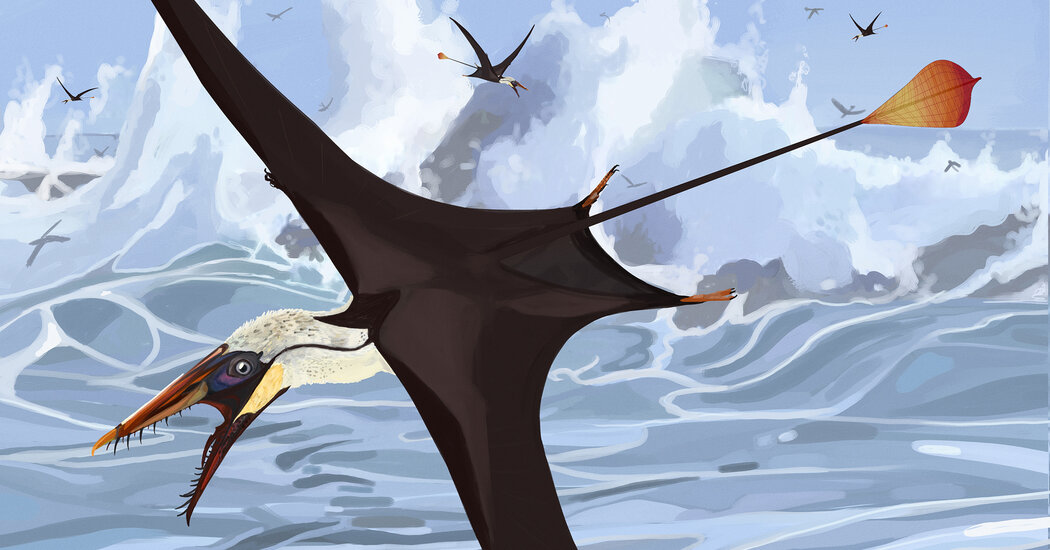Above the shores of prehistoric seas and lakes, Pterosaurus traveled across the sky. They have been feathered creatures that ranged in measurement from pigeons to plains, and the primary vertebrate animals that have been recognized to had managed to fly. And for thousands and thousands of years, that they had lengthy tails ending with a outstanding valve of the pores and skin known as a shovel.
Paleontologists have lengthy been questioning about this unusual appendage and its objective. A group of scientists utilizing laser scanning expertise has found new constructions in 4 pterosaur fossils that helped preserve the blade blade, suggesting that it helps maneuvering.
ResearchRevealed in December in Elife journal exhibits that “even fossils we have now recognized and studied intimately for a whole lot of years, there could also be new issues to indicate in case you are creating new expertise to see them,” stated Natalia Jagiel, Paleontologist on the Lime Museum of Regis in England and the main writer of the newspaper.
Dr. Jagiel, additionally knowledgeable artist, joined the analysis after Michael Pitman, a paleontologist on the Chinese language College of Hong Kong, turned to her as an instance a youngsters’s ebook. They have been united to see the pterosaur fossils in collections in England and Scotland.
After analyzing over 100 copies of pterosaurus, scientists have chosen 4 of the species Rhamphorhynchus., who’ve typically had diamonds, chatter caudal blades for monitoring with Laser -stimulated fluorescenceS Dr. Pitman and Thomas G. Kay, Director of the Scientific Progress Basis and the writer of the research, have promoted the method for exploring the stays of the dinosaur period and for the dinosaur period and for Archeological studiesS
The laser technique makes use of how some minerals glow when electrons take in after which radiate gentle once more. So
Photographs from the primary specimen of pterosaur they scanned confirmed a grille construction within the tail blade. For Dr. Pitman it was “Ta-Da A second. “
“It appears to be like like the kind of waffle cross,” he stated. “However this construction in engineering is a reinforcing construction.”
The “strings” of this grid may very well be helpful for flights, stated Dr. Jagielska. They are going to “tense when you have got a gust of air -like air -like air, and this in all probability reduces flicker” and should have helped the pterosaurus to “make turns,” she stated.
Scientists say that the primary operate of the blade might nonetheless be a social show, with the tail peacock feathers being a sign to draw mates. On this vein, the blade was most probably to have outstanding colours and patterns that aren’t preserved within the recording of the fossils, stated Dr. Pitman.
Nevertheless, as a contemporary billboard, the “show floor” wanted assist constructions that this research revealed in pterosaurs for the primary time, stated Dr. Pitman. If Vane was ignited, he can be “extraordinarily costly and on the identical time ineffective as a visible sign,” says Michael Habib, an skilled on pterosaur fields on the College of California, Los Angeles and writer of the research.
The result’s vital progress within the research of pterosaurs, stated Andrea Ca, a paleontologist in Italy who didn’t take part within the research. He famous that one of many fossils of the pterosaurus didn’t present any particulars of the delicate tissue utilizing different methods, however that laser fluorescence had taken them out.
“On condition that the rarity of soppy tissues stays in paleontology, even only a new fossil makes the distinction,” he stated.
Future research of pterosaur queues can illuminate, “How good this construction was like a rudder or as a stabilizer,” says Scott individuals, a paleontologist at Charleston School in South Carolina, who didn’t take part on this research. On condition that completely different pterosaurs have had completely different sizes of shovels, they will additionally present extra research whether or not this variation ought to do extra with flight optimization or “vogue”.
Dr. Jagielska wish to discover why lengthy blades with blades disappeared in pterosaurs till the start of the Cretaceous interval, about 146 million years in the past. Later laser scanning may reveal different traits which can be essential for the fields of pterosaurus. A greater understanding of their anatomy might even encourage air automobiles sometime.
“In the event that they have been so efficient that a whole lot of thousands and thousands of years might dwell, they in all probability do one thing proper,” stated Dr. Jagiel.

